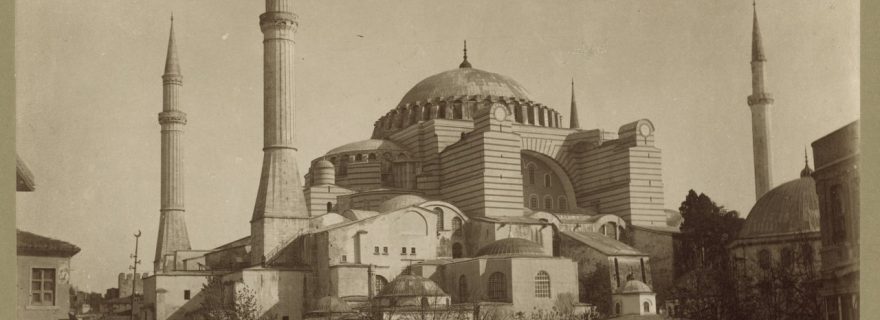Politics of Heritage and Heritage of Politics: The Case of the Hagia Sophia
The conversion of the Hagia Sophia into a mosque is nothing unusual for those who have been closely monitoring Turkey. Still, the knotted web of political conflicts and identity issues surrounding discussions of its role as heritage bespeaks the need to re-visit the concept of heritage itself.
On 10 July, Turkey’s President Recep Tayyip Erdoğan announced the conversion of Istanbul’s famous Hagia Sophia from museum to mosque. Erdoğan’s controversial decision appears to be motivated by a religious fervour that aims to put one more symbolic nail to the coffin of Turkey’s Kemalist legacy. However, the calls for the building to be converted into a mosque are by no means new. Populist Islamist segments of the population have been longing for this re-Islamization of Istanbul’s most monumental building— even while Erdoğan has been strategically postponing the decision to convert it. The decision of the government on 10 July was arguably an attempt to distract the public from the looming economic crisis. Yet, can the populist conversion of a world heritage site into a mosque tell us more about the politics of heritage and the conquest mindset in Turkey?
The relationship between the Hagia Sophia and rites of power is as old as its history. A UNESCO world heritage site since 1985, the Hagia Sophia was built more than 1,500 years ago as a Byzantine Christian cathedral, next to the area of the imperial palace. After the East-West Schism between the Roman Catholic and Eastern Orthodox churches, the Hagia Sophia was converted into a Roman Catholic cathedral during the Latin occupation of Constantinople, 1204-1261. In 1453, Constantinople was invaded by the Ottomans, who became the self-professed heirs of the Roman Empire. The new possessors of the city converted the Orthodox cathedral into a mosque, ending its thousand-year history as a Christian cathedral. The conversion served the functional and political needs of the Ottoman raison d’état as a world empire. It was the largest house of worship in the city. Additionally, it symbolized the legacy of Byzantium’s imperial power. The building served as the main imperial mosque during the rule of the Ottomans, even after the construction of another, even larger, mosque (the Blue Mosque) in 1616. The Hagia Sophia’s status as a mosque was therefore embedded in the conquest mindset and imperial politics of heritage-building.
Together with the Hagia Sophia, the city of Constantinople embodied the central power of two successive empires. Therefore, the conflicts over the city’s heritage already stretched beyond religious discussions. Following a 1934 decision of Mustafa Kemal, the final transformation of the mosque into a museum by the “secular conquest” of the Republic of Turkey ended, in a way, the imperial period of 1,500 years and declared the new and modern nation-state in place of old empires. This museumification also served as a peaceful gesture aimed at the Christian world and Turkey’s decimated Christian minority by acknowledging the multicultural history of the city. However, the “secular conquest” of Mustafa Kemal in 1934 did not reflect the interests of the predominantly rural and conservative Muslim majority left within the borders of Turkey in 1923.
In June 2019, opposition candidate Ekrem İmamoğlu of the Republican People’s Party (CHP) was elected as the mayor of Istanbul, ending the city’s years-long status as the major source of financial revenue for the Justice and Development Party’s (AKP) bureaucracy-business relations. As Alp Yenen explained in a post on this blog in 2019, the defeat of the AKP government in the municipal elections meant, for them, more than losing a municipality. They had lost the celebrated heritage of power and prestige, to the candidate from the CHP. Moreover, the defeat of the AKP demonstrated that a unified opposition, long lacking in Turkish politics, was emerging against the AKP government. Erdoğan’s decision in July 2020 was therefore also aimed at polarizing the secularists and Islamists through politics of heritage.
The conversion of churches and museums into mosques is nothing new under the AKP’s rule. One prominent example is the Byzantine Chora Church in Istanbul. Preserved as the Kariye Museum since 1945, the Chora Church had similarly served as a mosque during the Ottoman era, and was converted back into a mosque in November 2019. Previously in 2013, another Hagia Sophia church in Trabzon on the Black Sea coast—a region once dominated by Orthodox Christians—was opened to Muslim worship. This involved covering up the Byzantine frescoes inside the church. Less publicized but equally damaging “restorative conquest” was carried out in Edirne—a city in Eastern Thrace—over the past few years. These conquests comprise also non-religious heritage such as the ancient Assyrian and Kurdish town Hasankeyf in south-eastern Turkey. These destructions were less publicized in international media compared to the world-renowned Hagia Sophia in Istanbul, but they manifest nevertheless the multi-scale aspects of a revitalized conquest mindset.
Ironically, despite its conservative rhetoric, at every turn the AKP government has modified and re-invented the heritage of Turkey over the last ten years. Indeed, re-inventing buildingsis a practice that dates back to ancient times. However, in the case of Turkey, the re-invention is being carried out as a result of a conquest mindset. Unlike its historical imperial counterpart, the contemporary conquest mindset derives from the sovereignty cult of the nation-state paradigm, in order to legitimize the damage being done to shared world heritage. A truer reading of the nature of the Hagia Sophia’s most recent conversion requires that we look beyond Muslim-Christian, East-West, and Islamist-secular bifurcations, and examine the issue in a broader framework, as a manifestation of politics of heritage.



0 Comments